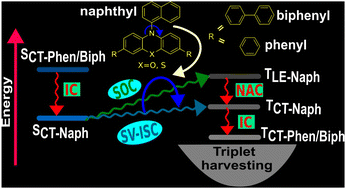Accidental triplet harvesting in donor–acceptor dyads with low spin–orbit coupling†
Abstract
We present an accidental mechanism for efficient intersystem crossing (ISC) between singlet and triplet states with low spin–orbit coupling (SOC) in molecules having donor–acceptor (D–A) moieties separated by a Sigma bond. Our study shows that SOC between the lowest singlet excited state and the higher-lying triplet states, together with nuclear motion-driven coupling of this triplet state with lower-lying triplet states during the free rotation about a Sigma bond, is one of the possible ways to achieve the experimentally observed ISC rate for a class of D–A type photoredox catalysts. This mechanism is found to be the dominant contributor to the ISC process with the corresponding rate reaching a maximum at a dihedral angle in the range of 72°–78° between the D–A moieties of 10-(naphthalen-1-yl)-3,7-diphenyl-10H-phenoxazine and other molecules included in the study. We have further demonstrated that the same mechanism is operative in a specific spirobis[anthracene]dione molecule, where the D and A moieties are interlocked near to the optimal dihedral angle, indicating the plausible effectiveness of the proposed mechanism. The present finding is expected to have implications in strategies for the synthesis of new generations of triplet-harvesting organic molecules.



 Please wait while we load your content...
Please wait while we load your content...